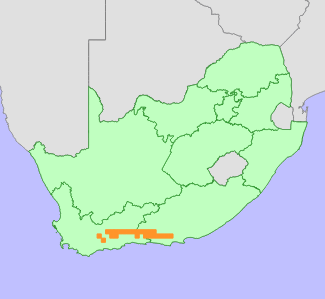|
Scientific Name | Leucadendron album (Thunb.) Fourc. |
Higher Classification | Dicotyledons |
Family | PROTEACEAE |
Synonyms | Leucadendron aurantiacum H.Buek ex Meisn., Leucadendron proteoides E.Phillips & Hutch. |
Common Names | Linear-leaf Conebush (e) |
National Status |
Status and Criteria | Least Concern |
Assessment Date | 2019/04/12 |
Assessor(s) | A.G. Rebelo, H. Mtshali & L. von Staden |
Justification | This species is widespread, common and not in danger of extinction. It is therefore listed as Least Concern. |
Distribution |
Endemism | South African endemic |
Provincial distribution | Eastern Cape, Western Cape |
Range | It occurs in the Swartberg, Langeberg, Outeniqua, Tsitsikamma, Kouga, Groot Winterhoek and Baviaanskloof mountain ranges between Swellendam and Uitenhage. |
Habitat and Ecology |
Major system | Terrestrial |
Major habitats | Swartberg Altimontane Sandstone Fynbos, Kouga Grassy Sandstone Fynbos, Kouga Sandstone Fynbos, South Kammanassie Sandstone Fynbos, North Kammanassie Sandstone Fynbos, South Swartberg Sandstone Fynbos, North Swartberg Sandstone Fynbos, South Rooiberg Sandstone Fynbos, North Rooiberg Sandstone Fynbos, South Langeberg Sandstone Fynbos, North Langeberg Sandstone Fynbos, Matjiesfontein Quartzite Fynbos |
Description | It grows on well-drained sandstone slopes in montane fynbos, 800-2000 m. Mature individuals are killed by fires, and only seeds survive. Wind-dispersed seeds are stored in fire-resistant inflorescences, and released after fires. It is dioecious, with insect-pollinated male and female flowers occurring on separate plants. |
Threats |
| Most of this species' habitat is in the protected areas, and there is no significant ongoing habitat loss. As a reseeder, this species is however potentially vulnerable to inappropriate fire management, particularly increases in fire frequency associated with climate change-related droughts. Recent field observations noted alien invasive plants present in the habitat of several subpopulations. These could outcompete native species in future if left unmanaged. |
Population |
Leucadendron album is a locally abundant species, that form dense stands (Rebelo 2001). As there are no severe threats to this species, the population is not suspected to be declining.
|
Population trend | Stable |
Assessment History |
Taxon assessed |
Status and Criteria |
Citation/Red List version | | Leucadendron album (Thunb.) Fourc. | Least Concern | Raimondo et al. (2009) | |
Bibliography |
Goldblatt, P. and Manning, J.C. 2000. Cape Plants: A conspectus of the Cape Flora of South Africa. Strelitzia 9. National Botanical Institute, Cape Town.
Raimondo, D., von Staden, L., Foden, W., Victor, J.E., Helme, N.A., Turner, R.C., Kamundi, D.A. and Manyama, P.A. 2009. Red List of South African Plants. Strelitzia 25. South African National Biodiversity Institute, Pretoria.
Rebelo, T. 2001. Sasol Proteas: A field guide to the proteas of southern Africa. (2nd ed.). Fernwood Press, Vlaeberg, Cape Town.
Vlok, J. and Schutte-Vlok, A.L. 2010. Plants of the Klein Karoo. Umdaus Press, Hatfield.
|
Citation |
| Rebelo, A.G., Mtshali, H. & von Staden, L. 2019. Leucadendron album (Thunb.) Fourc. National Assessment: Red List of South African Plants version 2024.1. Accessed on 2025/10/17 |
 Comment on this assessment
Comment on this assessment

